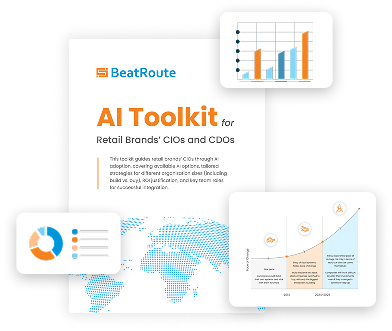The Ultimate Retail Marketing Handbook for Consumer Goods Brands

Marketing anything you want to sell and sell well is not optional. It’s mandatory and downright critical.
The point is letting your potential consumers know about your product and your brand. Even if you already have a renown in the market, your product still needs retail marketing.
Every product and every new launch needs to first grab consumer eyeballs and imagination before they can sell well. As your primary outlet to consumers, retail stores affect the bulk of your sales performance.
This article was crafted to help you explore all the aspects of retail marketing to successfully run your campaign. Read on!
What is Retail Marketing?
Retail marketing is a brand’s efforts to set up strategic relationships with retailers to ensure brand presence and product visibility. This involves positioning your products in the right areas along with agreements on pricing and promotion, inventory, visual merchandising, brand representation, regular communication with retailers, etc. All of these are focused on enhancing your marketing strategy, enhancing sales, and developing a concrete brand identity in retail.
Why is Retail Marketing Important?
As the collective efforts to promote and highlight your product in a retail environment, retail marketing is crucial to successful offtake.
Some of the benefits that are obvious in this regard are stated below:
- Consumer loyalty
Consumers keep coming back to you after a memorable experience that goes beyond plain quality. Quick issue resolution, lucrative loyalty programs, sampling kiosks all lead to sales that in turn, lead to repeat sales.
There is nothing like loyal consumers returning time and again to pick up more of your products. Consumer feedback requests, loyalty programs, and effective visual merchandising all contribute to the customer psyche that then leads to loyalty.
- Branding
Effective retail marketing is focused on repeatedly putting your brand in front of consumers. Your brand name in slogans, on displays and store fronts, on product promoter uniforms, and in digital marketing ads keep it fresh in the minds of consumers. This, coupled with dependable customer service and quality, leads to a strong brand value that pays dividends with time.
It is important to note that branding isn’t always explicit and actions like prompt issue resolution play a big role in building reputation. People tend to buy more from you when they trust you.
- Revenue boost
The most obvious benefit of retail marketing is heightened revenue. When consumers enter a store and see beautifully packaged items adorning the shelves or strategically placed product displays welcoming them, they are psychologically inclined to buy more.
Keeping consumers interested and driving quality improvement based on feedback are all contributors to revenue. Remember, the better the consumer experience, the more the sales.
Different Types of Retail Marketing
- In-store marketing includes some of the most important yet common marketing staples such as those found in a brick and mortar store. These could be signage, product demos, and electronic/physical displays.
For example, consider sampling. It is an effective and pretty straightforward tactic to get consumers to try out different products and make them excited enough to make a purchase.
- Online marketing is a potent avenue to reach consumers because of the rise of ecommerce today. The prevalence of social media platforms and marketing tools today make it all the more lucrative and unavoidable. It can do things that are mostly unrealistic in traditional marketing such as reaching global audiences. Some of these include:
- Email marketing
- Social media marketing
- SMS marketing
- Despite virtual interactions taking up precedence in marketing communications into the future, some consumers still prefer that human element in their correspondence. The next best thing to an actual person visiting homes is direct mail marketing comprising flyers, postcards, or catalogues. This is useful when targeting a specific geography or demographic.
- Seasonal promotions are available during the holiday season or other special occasions when specific conditions or priorities are in practice. These include giveaways, high-discounts, free gifts, etc.
- Event marketing is another retail marketing category where events are set up to directly promote or support a product. Consumers are free to visit these community gatherings or product launches to learn more about what’s on offer. When you bring consumers together at a gathering, you automatically make your product more popular.
Top Strategies in Retail Marketing
- Utilise emails and texts – Once you are able to profile your audience, you will be able to craft targeted emails that promote your product successfully. A healthy open rate will directly affect a significant chunk of shopping as you are able to reach multiple consumers at the same time. And with the right tool, you can and should automate your email marketing for maximum accuracy and effect.
- No strategy is complete without social media – Almost everyone today is on social media. This makes harnessing social media in your retail marketing strategy a foregone conclusion. What is important is to remember which platform you are promoting on and to modify your content accordingly.
For example, Instagram is excellent for pictures and videos while Facebook is more inclined towards a mix of text and other media. This means the consumers on these two social media platforms are more receptive to particular content and your retail marketing should reflect that.
- Visual merchandising – Putting up displays in stores, making your POS strategic product points or ensuring your planogram is adhered to are some of the most effective marketing tactics for your brand. Visual stimuli is incredibly powerful in getting consumers to buy from you because what they see matters to them.
A great product arrangement, a product promoter offering samples and even excellent lighting go a long way at attracting eyeballs. Here, it is also prudent to acquire a platform or tool such as BeatRoute that offers exceptional and seamless visual merchandising features. Such a software can benefit your merchandising team and ultimately, your brand, in identifying issues with planogram, space, etc., and resolving them for maximum effect.
- Google Ads are your best friend – Speaking of ecommerce, do what you may, sufficient organic traffic to your website is not a sure shot thing. In this scenario, Google ads are an excellent tactic to bring in more traffic to you. Google Ads allow your search results to show up on a SERP first and are perfect to grab attention away from other search results. You can direct traffic to your top product or to your brick and mortar store locations. And Google only charges you when someone clicks on your ad.
- Leverage the omnichannel approach – Omnichannel, as the name suggests, is using multiple channels to carry out your retail marketing. A single retail marketing campaign could utilise messaging (SMS), social media, ads, emails, and a robust website together to collectively affect consumers. This also has a hand at reducing the churn rate among consumers and offers memorable experiences. A positive side effect to harnessing so many channels to reach consumers is that your branding experiences a boost.
Retail Marketing Examples
- A brand selling herbal or plant-based products could use in-store displays featuring plants, the colour green, and natural ingredients, along with a slogan. These don’t necessarily show the product itself but consumers would get the feeling that this is a product that’s completely devoid of animal or synthetic components. Your marketing needs to bring forth the “feel” that you want to inspire in consumers and as such a display or social media campaign with just writing or random colours won’t do any good. Additionally, you could also partner with famous influencers that promote veganism or herbal products on their channels to appeal to your consumers’ psyche.
- Two brands can collaborate to combine their resources into a hyper-effective retail marketing campaign. For instance, if a famous footwear brand (A) were to collaborate with a chocolate brand (B), you would probably see it play out as: famous athletes or celebrities munching on A’s chocolate bar while walking down a road in their favourite B sneakers and telling the audience that it’s a great day for a walk! This promotes both the shoes as well as the chocolate.
Challenges in Retail Marketing (and Their Solutions)
- High costs – Retail marketing strategies that include extensive aspects like event marketing can require immense time and resources. Naturally, they also cost a lot to do effectively.
Solution – Take stock of your resources and determine what options you have. If something’s too expensive, redirect your efforts to economical but effective tactics like social media marketing.
- Physical limitations: In-store marketing and events necessitate adequate space and extra resources that online or virtual marketing efforts don’t.
Solution – This doesn’t always mean that you have to go the online route. Instead, you may contact your retailers and ensure they are onboard with your marketing strategy and that they can provide the necessary space for it. Communication comes before collaboration.
- Coming off as salesy – All retail marketing strategies have the end goal of selling a product or a service. What you don’t need to do, however, is be explicit with this agenda. Being too pushy with a campaign can actually put off consumers from buying your product and even negatively affect your branding.
Solution – The obvious solution is to provide a good experience to your consumers. They are more receptive to your goal, i.e. to get them to make purchases, when your product launch or brand has a story to tell in the marketing campaign instead of an outright sales pitch.
- Variable efficacy – No two things are alike and the same goes for retail marketing strategies. Your direct mails may not elicit the same response among a certain demographic as others or your product may not be big enough yet to justify an event.
Solution – Figure out what works best for your category. Look at your competitors, your product features, benefits, target consumers, and only after planning meticulously, implement your retail marketing strategy.
Measuring Retail Marketing Strategies
- ROAS or Return on Ad Spend – A crucial element in your retail marketing strategy, it equips you with data that tells you how an ad is performing; the price of the ad versus how much revenue or conversions it led to. Therefore, if you run expensive ads but don’t see a return that covers the costs, it is time to re-strategise. Remember, ROAS = total revenue of a campaign divided by the cost of the campaign.
- ROMI or Return on Marketing Investment – Similar to ROAS, this is a more direct KPI to determine how you are doing in terms of earning back the amount of money spent on marketing efforts. You divide your revenue with your marketing spend to assess your ROMI; you can utilise this parameter to both gauge success as well as scale your campaign.
- Repeat sales – The more consumers buy your products, the better your bottomline. However, what’s even better is when the same consumers keep coming back for more. A significant hurdle to overcome here is to keep them interested and retail marketing has a definitive role to play in that. When a marketing strategy tugs at consumer nostalgia or gets them wondering how a food product would taste or feel, your strategy has been successful. Therefore, if you can measure or identify repeat purchases, that’s one indicator of success and can be used for sales forecasts.
- Churn rate and funnel velocity – If you are actively losing consumers and your sales go down after a specific campaign, it is a sign that something’s not working. Additionally, you must be able to track your consumers through your marketing funnel. If their velocity through it increases with your newest campaign, then it’s a success and you can keep doing what you did.
- Cart size – One of the most basic and yet effective determiners of retail marketing success is the traffic in a store. This refers to people visiting a store and can be monitored with cameras or POS software. But more effectively – how much is each consumer buying from you? If you need to replenish stock more and more frequently with your retail marketing efforts, then it’s safe to say that people are taking notice and purchasing your products more. Your merchandising efforts and promotions, when based on empirical data and historical analysis, lead to this.
Conclusion
By implementing effective retail marketing strategies such as strategic product placement, targeted actions, and attractive visual displays, brands can significantly enhance their market presence.
Embracing these tactics attracts potential consumers while also nurturing brand loyalty and boosting overall profitability. Staying adaptable and continuously refining marketing approaches ensures continued success in a highly competitive space.
BeatRoute’s goal-driven sales technology ensures that retail marketing efforts, such as in-store promotions, planogram compliance/visual merchandising, and product visibility, are aligned with measurable business goals. With BeatRoute, there is a strong emphasis on achieving outcomes. We empower brands to optimise their retail marketing strategies, track campaign performance, etc. to improve customer engagement and sales.
Goa ahead and take a free demo today! We promise you won’t be disappointed.
FAQ
- What is the retail mix?
Ans: Also known as the marketing mix of retail, the retail mix is a combination of marketing elements or a marketing plan used to affect consumer behaviour towards business goals.
- What are the 4 ‘R’s of retail marketing?
Ans: The 4 ‘R’s of retail marketing are:
- Right product
- Right price
- Right promotion
- Right place
Use Goal-Driven AI to Achieve Retail Sales Uplift, Today!
Join enterprises in 20+ countries that trust BeatRoute, the globally dominant AI platform for sales force automation, field sales, DMS, and eB2B
Latest Ebooks & Reports
Download these free reports & ebooks to prepare your brands for future-ready route to market.


